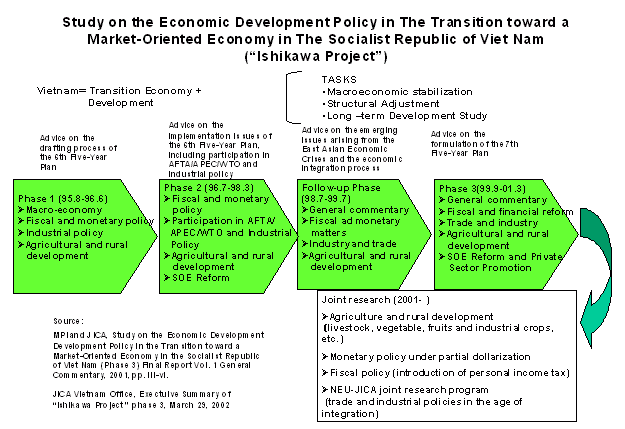|
 The project was officially agreed to by the governments of Japan and Vietnam when former Communist Party General Secretary Do Muoi visited Tokyo in April 1995. The Japan International Cooperation Agency (JICA) and the Vietnamese Ministry of Planning and Investment (MPI, previously the State Planning Committee) were the implementing bodies; and Shigeru Ishikawa, professor emeritus of Hitotsubashi University was appointed as the leader on the Japanese side. The "Ishikawa Project" was implemented jointly by the Vietnamese and Japanese teams over six years (in 3 main phases plus additional studies) from August 1995 to March 2001 and covered various areas including agriculture and rural development, trade and industry, fiscal and monetary issues, state-owned enterprises (SOE) reform and small and medium enterprises development as well as macroeconomic balance and responses to the Asian financial crisis. The project was officially agreed to by the governments of Japan and Vietnam when former Communist Party General Secretary Do Muoi visited Tokyo in April 1995. The Japan International Cooperation Agency (JICA) and the Vietnamese Ministry of Planning and Investment (MPI, previously the State Planning Committee) were the implementing bodies; and Shigeru Ishikawa, professor emeritus of Hitotsubashi University was appointed as the leader on the Japanese side. The "Ishikawa Project" was implemented jointly by the Vietnamese and Japanese teams over six years (in 3 main phases plus additional studies) from August 1995 to March 2001 and covered various areas including agriculture and rural development, trade and industry, fiscal and monetary issues, state-owned enterprises (SOE) reform and small and medium enterprises development as well as macroeconomic balance and responses to the Asian financial crisis.
 This project is considered a good example of Japan's intellectual ODA to Vietnam. Compared to the approach of the IMF and the World Bank, the Ishikawa Project is highly unique in its long-term orientation. As the project was initiated, three main tasks of the Vietnamese government were identified: (i) macroeconomic stabilization; (ii) systemic transition to a market economy ("structural adjustment"); and (iii) design and implementation of long-term development strategy. The Ishikawa Project declared to place the highest priority on the third task of long-term development. This is partly because the former two tasks had already been supported by the IMF and the World Bank and the Vietnamese authorities had recognized and begun responding to these challenges. But more importantly, it was because the problems faced by Vietnam were fundamentally different from those of Russia and Easter Europe where industrialization had been achieved to a large extent under the previous communist governments. In Vietnam, by contrast, the economy remained seriously underdeveloped, and its main task was not systemic transition but economic development. Therefore, strong emphasis was placed on long-term development and poverty reduction through industrialization. This project is considered a good example of Japan's intellectual ODA to Vietnam. Compared to the approach of the IMF and the World Bank, the Ishikawa Project is highly unique in its long-term orientation. As the project was initiated, three main tasks of the Vietnamese government were identified: (i) macroeconomic stabilization; (ii) systemic transition to a market economy ("structural adjustment"); and (iii) design and implementation of long-term development strategy. The Ishikawa Project declared to place the highest priority on the third task of long-term development. This is partly because the former two tasks had already been supported by the IMF and the World Bank and the Vietnamese authorities had recognized and begun responding to these challenges. But more importantly, it was because the problems faced by Vietnam were fundamentally different from those of Russia and Easter Europe where industrialization had been achieved to a large extent under the previous communist governments. In Vietnam, by contrast, the economy remained seriously underdeveloped, and its main task was not systemic transition but economic development. Therefore, strong emphasis was placed on long-term development and poverty reduction through industrialization.

|